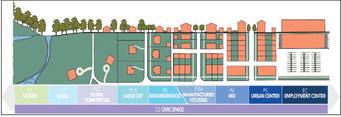City readies for zoning overhaul
The last phase of the Envision Taylor Comprehensive Plan is in sight, which means all properties within the city limits could soon be rezoned to allow for more flexibility for infill development.
At 6 p.m. on Tuesday, Oct. 10 and Thursday, Oct. 26, the city will be holding two public hearings on the draft ordinance, which according to a recent notice sent out to area real estate owners, could “determine whether you may lose the right to continue using your property for its current use.”
But city officials are saying this is a boilerplate notice, a standard requirement of state law and the new codes will allow for grandfathering.
“As far as what will change and what will not, any lots that don’t conform with the new regulations, if it’s even adopted, will be legal non-conforming,” said city spokeswoman Stacey Osborne. “So, if they were lawfully operating before the effective date, and they have been in regular and continuous use, for example, they can stay the same. There are very specific contingencies in there for people who are not conforming to the code right now.”
The draft ordinance called the “Taylor Made Land Development Code” was released Sept. 13 by San Marcos-based consultants SimpleCity. Design, which was charged with writing the draft ordinance based on the five big ideas of the comprehensive plan.
The ideas include preserving Taylor’s community character, offering a variety of housing types, promoting fiscal sustainability by using existing infrastructure, supporting local businesses and making sure people of all income levels afford housing.
“New development will be built as neighborhoods, not subdivisions,” according to the draft ordinance. “Our standards are not conventional zoning criteria found in other communities,” the ordinance continues. “The tools within the LDC are written with flexibility and clear intent. Providing creativity and allowances for different sites and development types through the use of the standards in the LDC (which) will ensure Taylor retains its character.”
Instead of traditional zoning, the city could soon be divided into different place types, most of which will allow for more intensive development, including eliminating lot minimums and allowing a variety of structures on different parcels — from accessory dwelling units to duplexes, and more.
Since earlier this year, city officials and Simple.City have held a series of events designed to share ideas and get stakeholder input to draft the ordinance, including at a “Design Rodeo” held May 3.
Realtor Julie Downs with Tierra Grande said based on the previous information presented, some of her clients purchased properties with the intent of developing them in ways that are no longer possible according to the current draft.
“What we saw in May is not the same as what we are seeing now,” Downs said. “We have clients who preplanned to be in compliance and are now having to re-plan. It is as though there isn’t an appreciation for our landowners and the costs incurred while trying to prepare for this plan.”
Still, Downs is fairly optimistic about the plan overall.
“There are some good characteristics of the plan, but we need to know which direction to plan for,” she said. “We have to choose a path, and let’s go down it.”
Brad Robbins, a real estate broker with Top Notch Properties, who has been working with the city on design charettes for years, said he thinks this will contribute to smart growth by emphasizing using existing infrastructure and allowing for more flexibility.
“I understand the need for the change,” Robbins said. “I think Taylor has done a really good job of segmenting things and creating documents that people can understand. With regards to zoning, it’s pretty straightforward with how they have laid it out.”
For more information, as well as a link to the draft ordinance, go to https://taylor. konveio.com/.

The city is considering replacing traditional zoning with new place types that will allow for more intensive development. Courtesy of the city of Taylor




